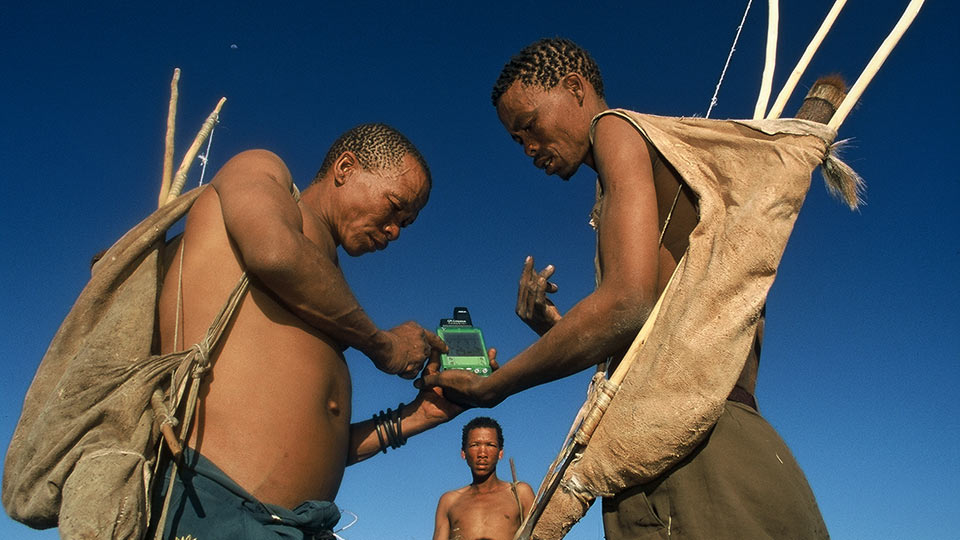A sympathetic way to stop sharks and people from killing each other
In December 2022, Oscar-winning director Steven Spielberg confessed to a sense of regret about how his 1975 film Jaws had catalyzed a hatred of sharks that he thinks contributed to a sharp decline in their numbers.
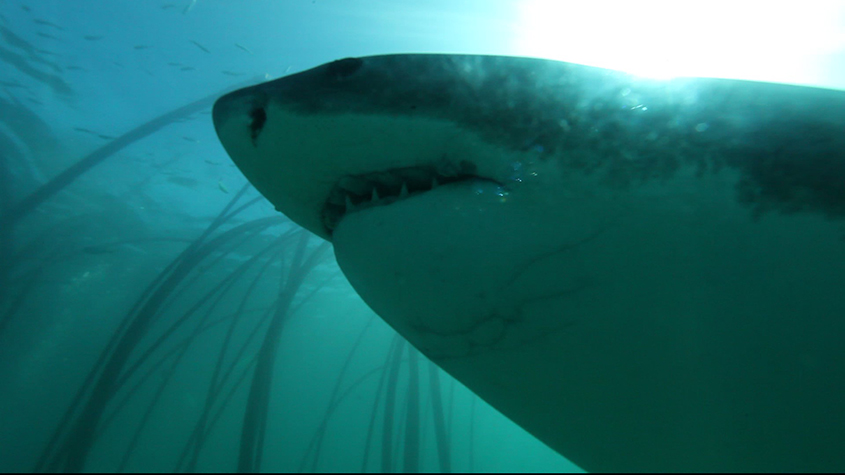
The filmmaker based his screenplay on Peter Benchley’s 1974 homonymous novel, which was thought to have been based on a series of shark attacks in 1916 that killed four people and injured one.
Whatever the truth, Spielberg believes their combined portrayal of a bloodthirsty killer fish sowed panic among American coastal communities and a ‘feeding frenzy of crazy sport fishermen’.
In truth, any responsibility that Jaws bears is minimal when compared to the impact of overfishing which, according to a 2021 global study published in Nature has caused a 71% drop in the worldwide population of oceanic sharks and rays since the early 1970s.
How likely is a shark attack?
Despite efforts by marine biologists to debunk the shark-as-maneater myth, the gory sensationalism resolutely persists in movies, on TV and in the news, and has real-world impacts on tourism and coastal economies.

In a bid to provide reassurance, governments around the world have implemented draconian anti-shark measures, such as nets and baited traps with hooks, called ‘drumlines’. But nets kill sea creatures indiscriminately, including dolphins, whale calves, and endangered turtles, while the drumlines also mete out a slow, painful death to anything that takes the bait.
And yet the prevailing expert opinion is that while these protections may comfort an anxious public, serious or fatal incidents involving sharks are very uncommon, despite humans’ increasing encroachment into the marine habitat.
Every year, the International Shark Attack File (ISAF)—the comprehensive database of all known shark attacks—reports on average as few as six shark incidents a year with fatal consequences for people.
Preventing shark attacks spurs marine conservation
If necessity is the mother of invention, then opportunity is its father—a truth borne out by a group of researchers from South Africa, whose waters are notoriously shark-infested, to devise a highly effective deterrent that’s harmless to sea life.
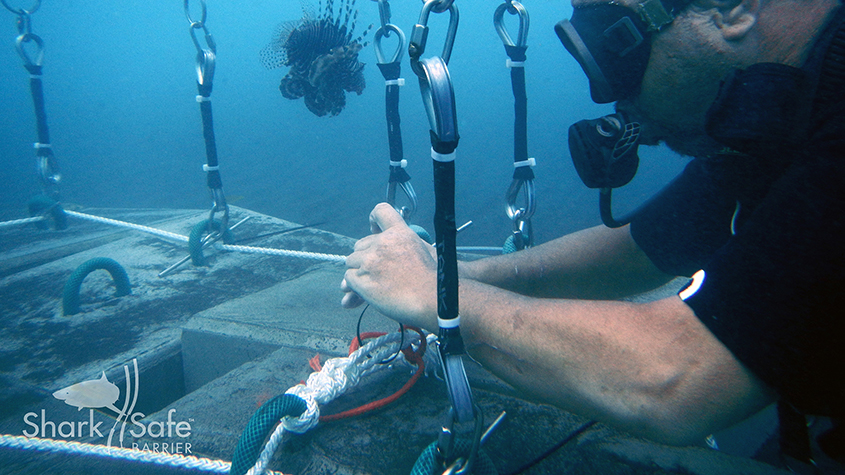
The Sharksafe Barrier™, whose names conveys the protection it affords to sharks as much as to humans, consists of four rows of magnetized, vertical tubes anchored to the seabed that resemble kelp swaying with the currents. Powerful ceramic magnets inside the pipes overstimulate the unique electrosensors found in sharks, skates, and rays—called the Ampullae of Lorenzini—which keeps the predators at bay but lets dolphins, turtles, and boats go sailing through.
Marine biologist and Sharksafe’s Chief Operating Officer, Dr Sara Andreotti, explained: ‘Solving the shark-human conflict has important socio-economic implications; one study in Reunion Island found that every shark attack caused an immediate 40% drop in tourism, or €20m per year. But it’s only by removing the trauma associated with shark incidents that discussions about shark conservation can happen.’
Eco-Friendly Shark Barrier with Seaweed-Forest Design
Look out for sharks
With shark welfare top of mind, Dr Andreotti’s team approached the problem from the animals’ point of view, starting with what they are known to avoid instinctively.
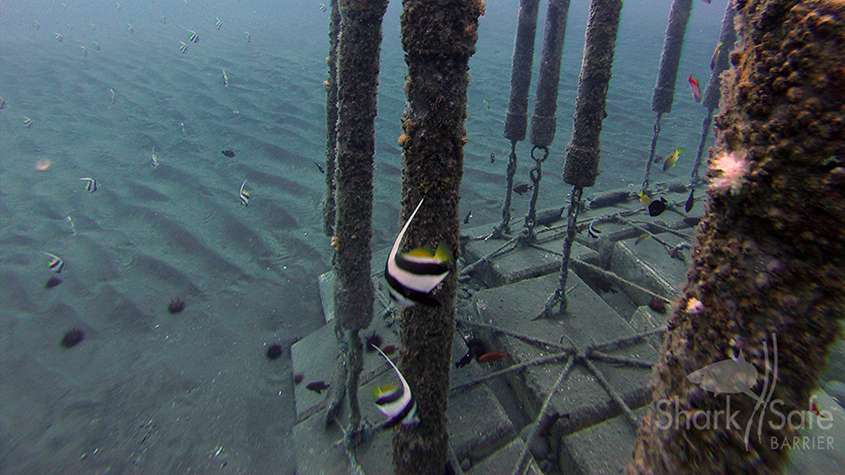
One of Sharksafe’s four inventors, Michael Rutzen, had noticed over years spent making marine documentaries that sharks recoil from kelp forests, even if it means foregoing a tasty seal that just nipped inside. This fact gave rise to the barrier’s seaweed-inspired look.
Magnetism—the second line of defence—was the input of coinventor Craig O’Connell—a former student of the pioneering shark-repellent researcher Dr Samuel Gruber—who selected the noncorroding, non-polluting barium ferrite rods used in the final product.
A Tried and Tested Solution for protecting beachgoers from shark attacks
After six years of trials and investigations to find the optimal materials, from the flexible anchors to the tubes and buoyant foams inside them, the Sharksafe Barrier™ was ready for market in 2017.

The team knew their product’s potential was enormous and, though confident in their creation, they tested it to the limits for five years in South Africa and the Bahamas. In all that time not one shark got through.
Dr Andreotti explained: ‘We created a square enclosure with the barrier and put a washing machine drum containing chum [chopped up fish, blood and oils used as angling bait] inside it. We set up cameras to film the chum bucket and the sharks’ behaviour outside. Between 2012 and 2017 we had active visits from 63 white sharks and 48 bull sharks, but none of them crossed. We are very confident in SharkSafe’s ability to dramatically reduce the likelihood of a human-shark encounter.’
Seeking Patents for an Infallible Shark Repellent Device
In 2012, the team asked Stellenbosch University’s innovation incubator, InnovUs, to shoulder the burden and costs of registering their intellectual property. In return, the university would own the IP but pay four-way royalties to SharkSafe’s inventors—Dr Sara Andreotti (COO), Dr Craig O’Connell, Prof. Conrad Matthee (CEO), and Michael Rutzen.

The University agreed, became a 20% shareholder, and filed an international patent application to seek potential protection for their product in a wide range of jurisdictions. Since then, the company has trademarked its name and filed further national and international patent applications for specific additional features (for example).
A shark deterrent device the whole world can profit from sustainably
As for their future, Matthee said: ‘Our main priority is to have Sharksafe Barrier™ in place protecting sharks. We’re more concerned about that than about making money. There’s a lot of demand for something smaller and portable that you can put in and take out, and we’ve had some inquiries from people wanting to keep crocodiles out, but we decided not to go that route and just focus on the core idea.’

Matthee believes protecting the IP had been a spark that lit a fire under the company’s prospects and potential.
IP was the first thing the university took care of, and everything started from there,’ he said. ‘Any interest from investors, their first question is about how protected your IP is. We landed two investors in the past two years that made a big difference to the company, and that was one of the first questions from them as well. It’s critical to any technology-based start-up.
Marine Conservation at the Heart of SharkSafe Barrier’s Values
The team is certain that their product is unique, a fact borne out by the patents which have been granted in Australia, Europe and the United States of America.
And now the business could be about to take off, with its first big sale secured in February 2023, and discussions are underway with prospective buyers in Australia, New Caledonia, and elsewhere with a shark problem.
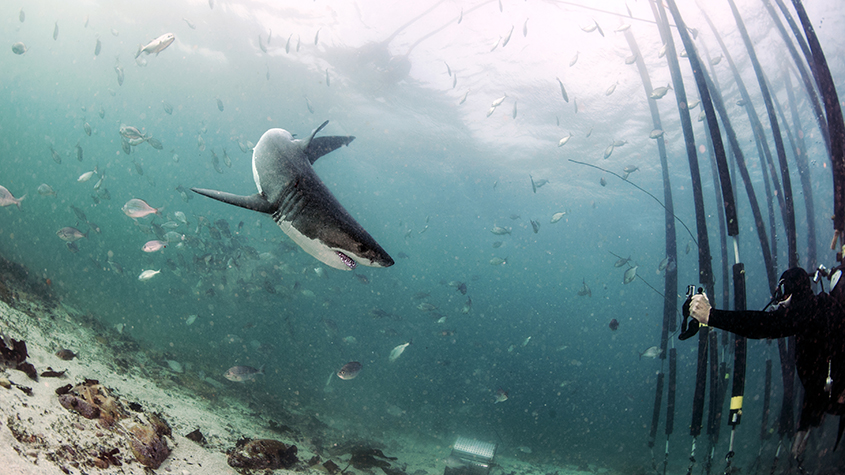
Be that as it may, CEO Conrad Matthee and his colleagues are driven not by profit but by marine conservation, the principal underpinning Sustainable Development Goal 14: conserve and sustainably use the oceans, seas, and marine resources for sustainable development.
Their focus on SDG Goal 14 earned the company a label of sustainability from the Solar Impulse Foundation, a space in the 1000 Ocean startups and the Uplink Word Economic Forum, and they also became an advocate for regenerative coastal tourism in the Ocean Innovator Platform, organized in Monaco by the Prince Albert II Foundation in March this year.
Around 40% of the world population lives in coastal communities, and marine resources are essential for them since the oceans provide livelihoods, subsistence and benefits from fisheries, tourism, and other sectors.
SDG 14 recognizes that oceans are essential to human wellbeing and social and economic development worldwide and swift action is needed to protect them. Their conservation and sustainable use are central to the 2030 Agenda, especially for small island developing states like the Bahamas, Reunion, and others that the SharkSafe Barrier™ has the potential to benefit.
